Exploring how integrating IoT in engineering systems is revolutionizing Telecom and Utility operations, enabling smarter asset management, predictive maintenance, and enhanced cybersecurity.
As the technological landscape is rapidly evolving, the integration of Internet of Things (IoT) technologies into engineering systems is not just a trend—it’s a necessity. The global industries are facing increasing pressures to enhance efficiency, reduce operational costs, and maintain competitive advantages, IoT emerges as a transformative force, particularly within Telecom and Utility sectors.
Challenges in IoT Integration:
While the potential of IoT is vast, integrating these technologies into existing engineering systems presents significant challenges.
- Legacy infrastructure often lacks the connectivity and adaptability needed to leverage IoT solutions fully.
- The sheer volume of data generated by IoT devices can overwhelm traditional data processing and analysis systems, leading to inefficiencies rather than improvements.
- Moreover, cybersecurity remains a critical concern as IoT devices can become entry points for malicious attacks, potentially compromising entire networks.
Opportunities Through IoT:
Despite these challenges, the opportunities offered by IoT are immense. Especially, for Telecom and Utility companies, IoT enables advanced asset management, such as:
- Real-time monitoring and condition assessment of critical infrastructure even in remote and inaccessible locations
- Predictive maintenance, powered by IoT sensors and analytics, allows for the early detection of potential equipment failures, reducing downtime and optimizing maintenance schedules.
- IoT-driven network optimization can improve resource allocation and enhance overall network quality, delivering better service to customers while minimizing operational costs.
IoT is not a stand-alone technology. The efficiency of connected devices not only depends on but thrives when the complimentary technologies are implemented tactfully. Amalgamation of Data & Analytics, AI/ML, and Cloud Engineering plays a crucial role in overcoming the challenges of IoT integration. By leveraging advanced data processing tools and AI-driven insights, one can ensure that the data generated by IoT devices is not just collected but transformed into actionable intelligence. This enables businesses to make informed decisions, whether it’s optimizing energy utilization, enhancing network security, or preventing fraudulent activities.
Best Practices for IoT Implementation:
For organizations looking to integrate IoT into their engineering systems, the following best practices can guide successful implementation:
- Begin with a Strategic Vision: Identify the specific business challenges you aim to address with IoT and define clear objectives for your IoT initiative.
- Ensure Scalable Infrastructure: Invest in scalable, adaptable infrastructure that can support the integration of IoT devices and handle the increased data load.
- Prioritize Cybersecurity: Implement robust security measures to protect IoT devices and the broader network from potential threats.
- Leverage Advanced Analytics: Use AI and machine learning to process and analyze IoT data, turning it into actionable insights that drive operational improvements.
- Focus on Interoperability: Ensure that your IoT solutions can seamlessly integrate with existing systems and technologies to maximize their impact.
Conclusion:The integration of IoT technologies into engineering systems represents a significant opportunity for Telecom and Utility companies to transform their operations and drive innovation. By addressing the challenges and leveraging the opportunities presented by IoT, businesses can unlock new levels of efficiency, resilience, and customer satisfaction. With Techwave’s expertise and advanced solutions, organizations are well-equipped to navigate the complexities of IoT integration and achieve sustained success in an increasingly connected world.
Explore AITechPark for top AI, IoT, Cybersecurity advancements, And amplify your reach through guest posts and link collaboration.

